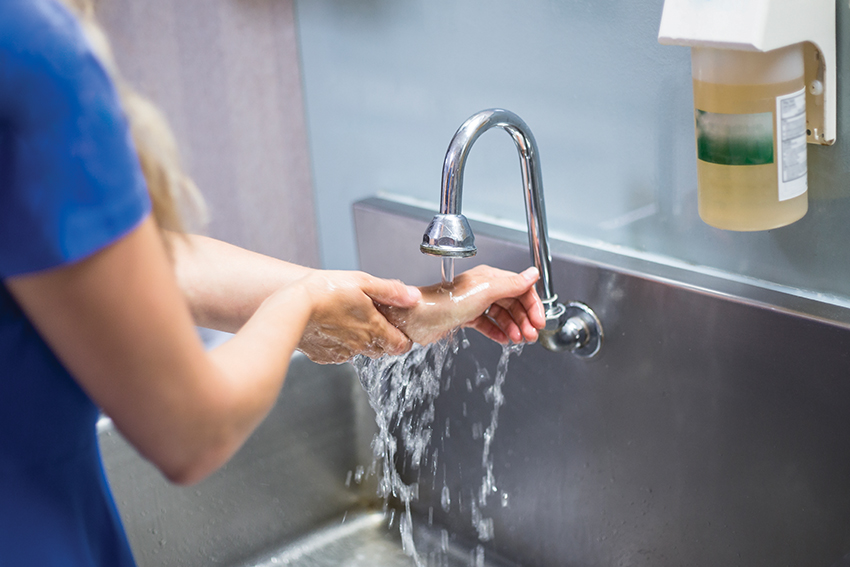
For healthcare operators seeking some sort of silver bullet for infection control, global infection prevention expert Peter Teska has some sage advice.
The key is not some new magical product, but rather it is about going back to the basics and following proper practices for all relevant cleaning and infection control practices.
“As a starting point, clean hands and clean surfaces go hand in hand,” says Teska, who provides technical support for healthcare offerings at Diversey, a provider of cleaning and hygiene products for multiple sectors, including healthcare, in the United States.
“So, it’s important when surfaces are being cleaned that they’re cleaned and cleaned properly. A typical bedrail or a light switch in a patient’s room might only get cleaned once a day. And if the cleaner isn’t diligent, you might find that the surface goes uncleaned for several days, which increases the risk of transmission of pathogens, which could ultimately result in patient infections somewhere else.”
Adding to the conundrum, the turnover of cleaners during the COVID-19 pandemic has risen dramatically, while existing staff have had to take on more reporting and compliance duties.
“This means facilities are having a harder time training people and they are struggling to follow the standard practices of infection control. When you take away a little bit of that oversight from infection prevention and you add in the layering of more frequent staff turnovers, you see that there are more opportunities for gaps in consistent performance of the infection prevention practices.”
That can manifest in inferior hand and surface cleaning, as well as flawed use of personal protective equipment (PPE).
Dr Greg Whiteley knows very well that implementing cleaning and disinfecting strategies in a hectic healthcare workplace is complicated. The executive director of Whiteley, a manufacturer of sterilants, disinfectants, and professional cleaning technologies, urges healthcare operators and cleaning contractors to stay vigilant with infection control.
“COVID-19 is clearly not over,” he says.
“There are more people dying now than there were in the first year of the pandemic, Plus, we’re in the flu season and there’s already been 15,000 reports in Australia since January.”
Dr Whiteley agrees that a consistent approach to infection control is crucial to combat viruses and bacteria that are transmitted from an infected patient to a surface and then to a hand.
“And the hand moves from place to place, person to person, so you’ve got to keep the surfaces clean and you’ve got to keep your hands clean. For example, we still see a lot of people using gloves as though they’re some sort of invisible force shield, but you should also be changing your gloves regularly.”
He acknowledges healthcare workers can overlook the risks of poor practices.
“They’re already under the pump, they’re short staffed, they don’t have time and they don’t have spare resources. It’s easy to skip a hand-hygiene moment or surface cleaning, or to get caught up and forget.”
Made to measure
As the healthcare industry contemplates the best way to manage infection control, Dr Gavin Macgregor-Skinner, senior director of the Global Biorisk Advisory Council (GBAC) in the US, champions the idea of building a stronger culture of measuring cleanliness.
“Then everyone would be able to work to a standard, and if they work to that standard they’d say, ‘It’s clean, it’s heathy, it’s safe because we measured it, we validated it.’ But we don’t do that.”
Observing the hotel sector, for example, Dr Macgregor-Skinner says he mostly sees “tidying up”, not proper cleaning. In hospitals, staff are so burnt-out that they may turn a blind eye to dust, dirt and unhygienic surfaces, or claim that it is not their job to address such issues.
“It’s everyone’s responsibility when it comes to safety and health in hospital environments, but they’re just exhausted.”
What Dr Macgregor-Skinner would like to see is a system of hygiene and cleanliness measurement whereby hospital and staff are rewarded for getting it right.
“It’s got to based on a positive reward system; it’s got to be incentivised. That may put some more strain initially on a fragile system, but you can’t walk into a hospital now and look at a monitor and see the cleanliness score of that facility.”
A shortage of healthcare workers in the wake of the pandemic has further complicated an already difficult infection control environment.
“The healthcare system has not recovered,” Dr Whiteley says.
“It’s chronically understaffed. Elective surgery lists are quite ridiculous. So, there’s a whole issue about even the timing of training if you don’t have enough staff to run wards.”
Teska says the difficulty in recruiting and retaining cleaners to work in hospitals and healthcare facilities is clearly complicating efforts to meet infection-control standards.
“They tend to be some of the lowest-paid people in a hospital or health system. As a consequence, they have lots of other opportunities for employment on roughly the same wage where most of the day is spent answering customers’ questions or managing relatively simple tasks. Whereas, it’s a hard physical job to do cleaning for the environmental services team and a healthcare facility, and not everybody wants to sign up for it. And as wages in other areas have gone up because of inflation in the last two years, we haven’t necessarily seen wages for environmental services workers keeping pace. That reduces the available pool of workers.”
Teska says the “obvious answer” to solve the problem in countries such as the US or Australia is to increase immigration rates and provide a pathway for those people to enter healthcare and environmental services roles.
Mitigating cross-contamination risks
Lorenzo Tadeo, marketing director – professional division of Freudenberg, which owns the Oates and Vileda Professional brands, says proper training and the ability of product providers to clearly manage and advise clients on the best cleaning and infection-prevention processes is crucial to mitigate cross-contamination risks in vulnerable settings.
Tadeo is proud that members of his team – which represent the Oates and Vileda Professional brands – go through training from ISSA, the worldwide cleaning industry association. This helps give them the knowledge and credentials to advise healthcare clients properly.
“It’s about making sure that all the different pieces of the puzzle are linked together and give the best results,” he says. “Because I can give you the best mops in the world, or you can use the best chemicals in the world, but if the mop is not washed properly or the system is not used correctly then it’s basically useless.”
Tadeo says such consultation covers the gamut of workers in hospitals and healthcare settings.
“Our account managers have been all trained to work as advisors for the hospital in not just in the cleaning process. We talk with the laundry, we talk with the facility manager, we talk with the cleaners, we talk with the nurses, we talk with the infection controllers to make sure that we don’t miss anything and that we really help them achieve the best result.”
To minimise cross-contamination risks and reduce outbreaks in healthcare facilities, Tadeo says the “king of hygiene” is still hand washing.
He says the starting point for infection control is to avoid shifting dirt from one space to another through a “pre-prepare” cleaning methodology whereby flat mops and cloths used for cleaning floors and surfaces are pre-saturated with cleaning solutions and then used in a specific area.
“Therefore, when you have cleaned one area, you replace the product with another one. You always use clean products.”
This minimises as much as possible the risk of cross-contamination from one area to another.
He adds that discussions with the hospital or healthcare facility about the expected level of cleaning are also crucial. There will be different levels for the main entrance of a facility compared with a ward or emergency department.
“In intensive care or an operating theatre, for example, you might prefer to use single-use microfibre products.”
‘Layered interventions’ the key
As part of an ongoing commitment to their patients and customers, Dr Whiteley says it is in the interests of all healthcare operators to up the ante on the basics of cleaning and infection control such as hand hygiene.
Doing so will deliver better health outcomes – and it could also benefit their bottom line by minimising their dependence on companies such as Whiteley that are producing infection-control technology. “The status quo is keeping us all in business,” he says.
“I mean, hospitals want to spend less on our products and maybe if they did more of their frontline hand hygiene and cleaning, they’d spend less overall because they’d have cleaner hospitals.”
For Teska, the pandemic is something he never expected to experience in his lifetime. Previously, he had just inherently believed that such a crisis would see people “follow the science” on infection control and illness prevention.
“But what we’ve actually seen is a struggle getting people to understand fundamentally the value of things such as vaccination and washing hands and the wearing of a face mask.”
He still focuses on all three actions, especially while travelling and despite being double vaccinated and double boosted.
“If you follow that approach, you see that layered interventions are typically far better than a single intervention relied on to solve the problem,” Teska says.
“If you get exposed to SARS-CoV-2 or some other respiratory virus, maybe you won’t become infected. But adding some of these additional precautions is helpful and protects other people as well. And that is essentially an extension of why we do these infection prevention practices in healthcare.”
This first appeared in the May/June issue of INCLEAN. To read the article in full, click here .
Comment below to have your say on this story.
If you have a news story or tip-off, get in touch at info@incleanmag.com.au
Sign up to INCLEAN’s newsletter.



